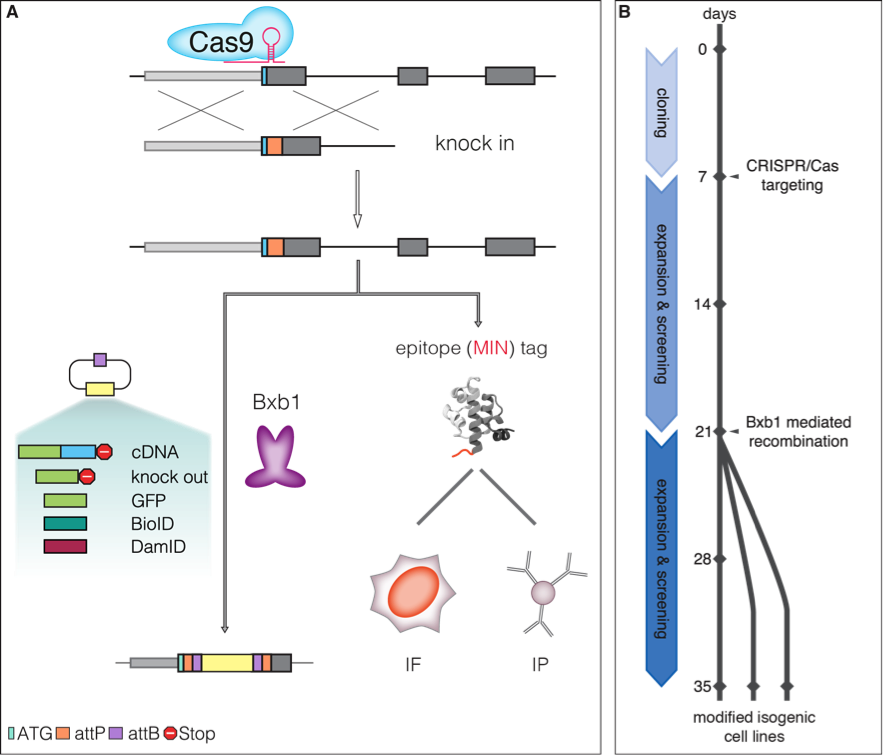MIN-tag targeting guide
INTRODUCTION
MIN (Multifunctional Integrase) Tagging allows the rapid and versatile manipulation of a gene of interest through the use of an
inserted MIN (Bxb1 attP) sequence either immediately
following the first codon or before the stop codon of a gene of interest.
This site acts not only as a genetic entry site for the phage serine integrase
Bxb1but also as an epitope tag for a highly specific rat monoclonal antibody
suitable for use in immunoprecipitation and immunofluorescence. In a second
step, Bxb1 can be used to recombine in any of the library of openly available
pre-fabricated cassettes into the MIN site, allowing the efficient generation
of numerous modified cell lines from a single entry cell line.
Detailed instructions and protocols can be found HERE |

|
Using the MINtool to Design Your MIN-tagging Strategy
Background
The MIN tool assists users in applying the MIN tag strategy to a given gene of interest (GOI). The MIN-tag strategy relies on the presence of the MIN tag within the coding sequence of a GOI, either immediately following the start codon or preceding the stop codon. To accomplish this, we employ the CRISPR/Cas9 system (Cong et al. 2013). This system uses a guide RNA (gRNA) to sequence-specifically target the bacterial Cas9 nuclease to create a double stranded break (DSB). We use the system to induce the DSB proximal to the site where the MIN-tag is to be inserted. This break can then be repaired with a MIN-tag donor, harboring the MIN-tag sequence and is homologous to the sequences 5´and 3´of the DSB.
Therefore, the insertion of the MIN-tag at a GOI requires:
The MINtool facilitates the identification of gRNA targets proximal to the start or stop codon of a GOI. Once a gRNA target is chosen, the MINtool will produce a file containing the oligos needed for cloning the chosen gRNA into Zhang Lab (www.genome-engineering.org) plasmids, as well as the necessary GOI-specific MIN-tag donor.
Step I: Choose Gene and Organism
Choose the gene you would like to MIN-tag as well as the organism you are working with in the top bar.
Step II: Choose an isoform
Genes often have numerous isoforms due to the use of alternative transcriptional start sites and splicing. Thus a gene might have isoforms using different upstream or downstream start or stop codons. Therefore, it is important to carefully consider which isoform to choose when applying the MIN tag strategy.
Step III: N- or C-terminal Tagging
The choice of N or C terminal MIN tagging is dependent on the downstream applications desired by the user. Both options can be used to create fluorescent and enzymatic fusions. However, N-terminal targeting allows the most flexibility, as it offers the possibility to knockout the gene using the "knockout cassette" as well as the replacement of endogenous gene products with cDNAs. This type of tagging is necessary for studying point mutants or domain deletions.
Step IV: Choosing a gRNA
The CRISPR/Cas9 system has a sequence requirement of N21GG for gRNA targeting. All of the potential targets on either strand within 100 bp 5´ and 3´ of the ATG (red) are depicted. If possible, we recommend choosing a gRNA target sequence, which will be disrupted upon MIN-tag insertion. Failure to do this can result in additional, unwanted mutations at the gRNA target sequence.
Step V: Export Sequences
The sequences can now be exported as a spreadsheet by clicking on the "generate oligo" button. The MIN-tag donor can be ordered as a ready-to-use 150bp ssDNA oligo. The oligos for the gRNA are designed to be used in one of the Zhang Lab (MIT, www.genome-engineering.org) plasmids (px330, px335, px458 available at Addgene ) which contain two expression cassettes, Cas9 and the gRNA.
Cloning the GOI-specific gRNA
The MINtool generates oligos that are suited for cloning into the Zhang Lab vectors. For more details see:
Ran, F. A., et al. (2013). "Genome engineering using the CRISPR-Cas9 system." Nat Protoc 8(11): 2281-2308.
 Ran et al. Nat. Protoc. (2013). 8, 2281-2308
Ran et al. Nat. Protoc. (2013). 8, 2281-2308
Schematic overview of the targeting workflow
